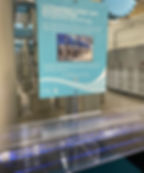California to approve recycled drinking water
- Peter Yollens
- Jul 14, 2023
- 3 min read
Updated: Jul 14, 2023

In June, I toured the Silicon Valley Advanced Water Purification Center, which receives the output from Santa Clara County’s treated wastewater facility next door. The Center already produces water that is clean enough to drink using a treatment sequence of three proven purification methods: microfiltration, reverse osmosis and ultraviolet light with hydrogen peroxide. Advanced oxidation is a planned fourth step.
Source: Silicon Valley Advanced Water Purification Center
Currently, though, it is piped to a groundwater infiltration pond, where it drains into the groundwater for future use. This groundwater recycling process is called “indirect potable reuse.” The world’s largest indirect potable reuse system is located in Orange County, California and uses that same three-step process to produce enough clean water for 1 million people per day.
It’s “indirect” because the treated water does not go straight into the drinking water pipes of the system, which some people think is icky. The ick factor has prevented California’s water utilities from recycling and reusing even more because it’s hard to find places to recharge groundwater. This is all about to change however.
California’s water regulator, California Water Resources Control Board, announced this week that it would issue new guidance by the end of 2023 that will allow utilities to convert wastewater into high-quality drinking water. Water systems would then be able to add treated wastewater that meets or exceeds drinking water standards to their potable supplies and systems. This is sometimes derisively called “toilet-to-tap.” In reality, all water that ever existed is recycled and nature does a good job at removing contaminants and impurities. Now, scientists have developed processes that mimic and accelerate these natural processes using filters that substitute for soil, membranes that substitute for evaporation, and ultraviolet light that substitutes for sunlight. In fact, the recycled water is of higher quality than many public water systems, and ERC portfolio company Epic Cleantec even brewed and distributed beer with recycled wastewater to sway public perceptions that recycled treated wastewater is safe and tastes great.
I’m a big fan of this pathway because the water being injected into groundwater basins already is clean enough to drink and could pass the state’s standards. And yet, it’s only been public perception that has held back our state regulators from allowing “direct potable reuse,” which, incidentally, was the reason for the tour – to positively influence public opinion. This is such a big deal because it positively unlocks so much value all at once. Water systems will be able to improve their water supply reliability; lower their energy intensity and carbon footprint; and improve the financial stability. This change will also serve to expand the markets for critical technologies that have been piloted and tested and have needed greater commercialization to realize their financial potential.
A few months ago, I wrote about my trip to Israel, which recycles 90% of their municipal wastewater, compared to California which recycles just 10%. With smart regulation, California and other states could catch up and become more drought-resilient along the way. After all, the most reliable source is the local water we already have.
Here are some additional photos from my tour of the Pure Water Facility reflecting the three steps in the treatment process:
1. Vertically-oriented micro filtration area.

2. Horizontally-oriented reverse osmosis membrane cutaway shows how the layers get rolled up.

3. Ultraviolet (UV) Disinfection.

Thank you for reading my recent post and following Echo River Capital.
- Peter


